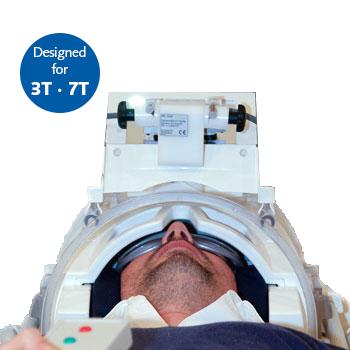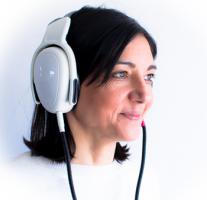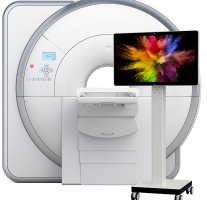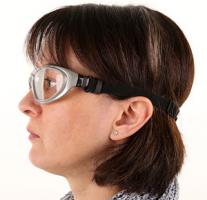MR Safe Eye Tracking for fMRI / LiveTrack AV for fMRI
LiveTrack AV for fMRI

Questions about LiveTrack AV for fMRI?
LiveTrack AV for fMRI is an affordable video eye tracking system which provides real-time estimates of eye rotation, Direction of Gaze coordinates and pupil size. A live video stream from the eye tracking camera is available concurrently with the data so you can visually monitor and check your observer's behaviour throughout the experiment.
Note: the indicated Guide Price is for the monocular configuration and includes one opto-mechanical mount.
![]() M0203 LiveTrack AV for fMRI Datasheet
M0203 LiveTrack AV for fMRI Datasheet
Guide Price: £20000
SKU: M0203
What does the Guide Price include?
The indicated guide price refers to a monocular configuration with one camera with integrated 950nm IR LED, your choice of Camera Mirror Mount, and the LiveTrack AV signal processing unit.
How fast does it track?
The camera runs at a fixed sampling rate of 60Hz. The LiveTrack AV signal processing unit runs in real-time and generates a tracking result for each sample from the camera. The results are streamed to a computer on USB.
Which head coils are compatible?
The LiveTrack camera can be connected to most 1.5T and 3T head coils. Specially designed Camera Mirror Mounts are available for almost all current scanner manufacturer supplied head coils - click here for a full list. If your coil doesn't appear on our list, contact us to discuss a custom solution.
Can the participant wear glasses?
Yes! Obviously, only MR Safe glasses can be used in the scanner room. We recommend the MediGlasses.
Does the eye tracking work with all participants?
Provided that the pupil is visible to the camera, most participants can be tracked successfully. Eye colour, eye and eyebrow cosmetics (make-up), contact lenses and glasses are not usually an issue.
How is LiveTrack calibrated?
Calibrating Direction of Gaze coordinates is easy and takes less than a minute with the free LiveTrack Viewer software utility.
The geometry of your setup is inferred by having the participant fixate on a sequence of nine dots presented at known locations on the stimulus display. Just input the viewing distance between the participant's eyes and the stimulus display, then instruct them to locate the targets as they appear one at a time. When the eye rotations to all nine locations have been measured, the Utility calculates a calibration matrix which determines the relationship between eye rotation in camera coordinate space and screen position in degrees for all subsequent measurements. The matrix is uploaded to the LiveTrack AV signal processing unit and automatically applied to the tracking data that is generated by the unit. After the initial calibration has been performed, a very simple drift correction can be performed between each trials using a single, one-dot calibration that takes just a few seconds to complete.
Must I use the LiveTrack Viewer for calibration?
Absolutely not! You are free to implement your own custom calibration. We supply template scripts that use Psychtoolbox-3 and MATLAB to explain how to create a custom calibration.
What kind of stimulus display do I need?
You can use any MR compatible display or rear projection screen, but we recommend our BOLDscreen range of MR Safe LCD displays for easy and simple integration.
What does the LiveTrack AV signal processing unit do?
Eye tracking is a computationally intensive task. That's why most eye trackers use a PC to crunch their data. LiveTrack AV is different. The compact, smartphone-sized processing unit, uses a custom embedded microprocessor whose sole task is to capture samples from the camera and then calculate eye rotation and pupil size. The processed data is then streamed in real time to a computer on USB using a high-speed USB2 interface.
What software is included?
LiveTrack is provided with an easy to use software utility for calibration, real-time feedback and simple logging of data. For further integration, the LiveTrack USB HID and USB CDC protocol interfaces allow you to get the data directly into your own MATLAB, Python and C software, and to third-party software like NBS Presentation and ePrime via their serial port (COM port) data capture systems.
Can I synchronize the data with other equipment?
Yes. The LiveTrack AV signal processing unit has a 1-bit TTL-compatible input on an SMB connector. This input is sampled at the same time as the camera captures an image of the eye and can be used to indicate the status of stimulus (e.g. stimulus onset event generated by a PC parallel port or DAQ), the progression of the MR sequence (by connecting the trigger produced by the MRI scanner), or from any other equipment that can generate a TTL-compatible voltage. The input can also temporarilly be reconfigured to reset the frame count of the data stream, which is particularly useful for binocular configurations that use two synchronised cameras.
What data does LiveTrack produce and how can I use it?
LiveTrack streams two kinds of data via high-speed USB2 on a single USB cable. Video data from the camera is streamed to the computer using USB UVC (Video Device Class), just like a webcam. This is useful for monitoring the participant's behaviour during the experiment. The video frames captured from the LiveTrack AV camera are overlaid with the current eye tracking data quality metrics (e.g. pupil and glint detection; camera frame counter). Eye tracking data is streamed to the computer using the USB HID (Human Interface Device Class) and/or USB CDC ACM (Communication Device Class Abstract Control Model) protocols.
Can I record or view the raw video?
The raw monochrome video feed from the camera is available in analogue NTSC format. It can be captured by a third-party frame grabber simultaneous with the tracking performed by LiveTrack AV signal processing unit. The NTSC video feed can also be connected to a standard coaxial input on any TV in place of the usual input from an aerial. Many options are available for grabbing the raw NTSC video depending on the computer and software that you want to use to inspect/analyse the raw video, but none is included in the standard package. Let us know if you would like us to add the option to your quote.
What are the system requirements for LiveTrack?
LiveTrack is compatible with all computers and recent operating systems that support USB devices.
Though not an exhaustive list, we've tested the following operating systems:
- Microsoft Windows: Windows 7 or later (Windows 10 recommended).
- Apple Mac OS X: El Capitan (10.11) or later.
- GNU/Linux: Any recent edition. Ubuntu Linux: 14.04 LTS or later recommended.
What drivers do I need to install?
We have chosen deliberately to implement industry-standard USB Device Classes: MSD, HID, ACM CDC, and UVC. No special or proprietary drivers need to be installed on any operating system. When the LiveTrack AV signal processing unit is connected to the computer, the host will automatically detect the enabled USB interfaces and will load the necessary drivers that are included natively with the operating system. The only manual intervention that is required is on versions of Windows prior to Windows 10; we provide a signed INF (driver information file) which instructs Windows to load the Microsoft USB CDC driver (usbser.sys) when the LiveTrack USB CDC interface option is enabled.


